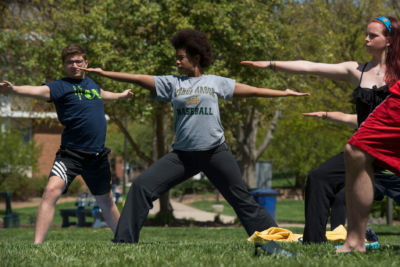By: Amber Myers, RYT 200, SHRM-CP
“Leadership is not about titles, positions, or flowcharts. It is about one life influencing another.” – John C. Maxwell
When most people think of yoga, they picture the physical poses – the stretches, the balance, and the movement. But that’s only a fraction of what yoga really is. Yoga is made up of eight limbs, and the Yamas and Niyamas are the first two limbs of that system. At its core, yoga is about the connection between the mind and body. The Yamas and Niyamas help bridge that gap by giving us a guide for how to move through the world, both internally and externally. Leadership works the same way. Just like yoga isn’t just about movement, leadership isn’t just about hitting goals. Leadership is about how you show up and lead from within. Here is why your mindset is vital when you practice both yoga and leadership, and how to apply yoga principles to leadership to boost your success and well-being.
Focusing only on external factors you can’t change – such as policy changes, market fluctuations, and deadlines – can make your leadership more reactive than intentional.
Research by Treviño suggests that people with an internal locus of control – who believe their actions directly impact outcomes – are more likely to take responsibility for their decisions and behaviors. This mindset is essential in ethical leadership, where self-awareness and accountability shape how we guide others, according to research by Brown and Treviño.
My Experience Connecting Yoga Principles to Leadership
The first time I stepped onto a yoga mat, I had no idea it would become my reset button. Back in 2014, I was dabbling—sometimes practicing consistently, other times letting weeks slip by. But no matter how long I strayed, I always returned to yoga. Over time, I realized it was the one thing that always helped me feel like myself again. Whenever I felt stressed or just unmotivated, I knew I had probably been neglecting my practice for too long.
In 2021, I earned my Registered Yoga Teacher (RYT 200) certification. My goal wasn’t necessarily to teach; I wanted to deepen my physical practice. But by the time I completed the training, I walked away with more than a better understanding of the asanas (physical postures). I also gained a new perspective on yoga as a way of navigating life – especially its ethical foundations.
As part of my training, I was required to read The Yamas and Niyamas: Exploring Yoga’s Ethical Practice by Deborah Adele, and I immediately connected with it. The principles weren’t just philosophical; they were practical. They gave me a way to think about life beyond what was right in front of me, acting as a set of guiding ethics that I could return to when making decisions, setting boundaries, or even just understanding my patterns. Like the physical practice, these principles also became my calibration system.
As I absorbed these principles, I started to see how they extended beyond my physical yoga practice. They weren’t just relevant on the mat – they applied to how I moved through the world, including in my professional life. Alongside my yoga journey, I also grew in my Human Resources (HR) career through the years, working my way up to becoming an HR manager. Through these years, I’ve worked with all kinds of leaders, some great and some not-so-great. I’ve also stepped into leadership roles where I influenced a project or team in some form or fashion. And through it all, I’ve learned that leadership isn’t about a title; it’s about impact.
The more I sat with the Yamas and Niyamas, the more I realized:
- The Yamas (external ethics) shape how we interact with others – essentially how we lead.
- The Niyamas (internal ethics) shape how we interact with ourselves, our mindset, discipline, and personal growth.
When we apply these principles to leadership, we lead with intention and cultivate stronger, healthier team cultures.
Why Leadership Needs Ethical Grounding
There are many conversations surrounding leadership styles, performance management, and decision-making, but what about the values behind those approaches? Some of the biggest leadership challenges I’ve seen include:
- Burnout: Leaders are stretched thin between managing their teams and their own workloads.
- Ineffective communication: When expectations aren’t clear, it causes confusion and disengagement within the team.
- Lack of engagement: A leader sets the tone for the team. When they’re disengaged, the team notices, and it impacts morale.
I’m not saying the Yamas and Niyamas will make these challenges disappear overnight, but they can shift how leaders approach them. Instead of focusing on what’s outside their control, these principles help leaders focus on what is within their control: their actions, communication, and the environment they create.
The Yamas: How External Discipline Shapes Leadership
The Yamas and Niyamas: Exploring Yoga’s Ethical Practice defines the Yamas as how we engage with the world and those around us. In leadership, these principles guide how we interact with our teams, set expectations, and build culture.
- Ahimsa (non-violence) – leading with compassion: Instead of assuming a team member isn’t performing well, ask: What’s happening? What support do they need?
- Satya (truthfulness) – honest and transparent leadership: Instead of hiding upcoming changes, be open. Share what you can, even if you don’t have all the answers.
- Asteya (non-stealing) – giving credit where it’s due: If junior employees contribute to a project, acknowledge their role publicly instead of taking credit.
- Brahmacharya (moderation) – avoiding burnout and prioritizing energy wisely: Avoid sending emails after hours unless urgent, and model work-life balance for your team.
- Aparigraha (non-possessiveness) – letting go of control and embracing flexibility: If a project isn’t going as planned, step back and ask, “What’s working?” and “What needs to change?”
The Niyamas: How Internal Discipline Shapes Leadership
The Yamas shape how we lead externally, and the Niyamas guide how we lead ourselves, according to The Yamas and Niyamas: Exploring Yoga’s Ethical Practice. Leadership isn’t just about how we interact with others – it’s also about self-discipline, personal growth, and mindset.
- Shaucha (cleanliness) – clear, organized leadership: Setting clear meeting agendas and providing direct, actionable feedback.
- Santosha (contentment) – leading with gratitude and perspective: Recognizing small wins helps build resilience during challenges.
- Tapas (self-discipline) – leading by example: If leaders expect those they lead to follow through on tasks, leaders should demonstrate that themselves.
- Svadhyaya (self-study) – reflection and continuous learning: Seeking feedback from direct reports and using it to improve leadership style.
- Ishvara Pranidhana (surrender) – leading with purpose and humility: Leaders who focus on shared goals rather than micromanagement create more engaged teams.
Bridging the Gap Between Yoga and Leadership
Leadership, like yoga, is a practice. People often say, “I can’t do yoga because I’m not flexible.” But flexibility isn’t the goal; consistency is. Yoga is about showing up, practicing, and growing.
The same goes for leadership. You don’t need to have it all figured out. You just need to be intentional about how you show up.
Your Call to Action
Which of these principles resonates with you the most? How can you apply it in your leadership today?
Start small – because leadership, like yoga, isn’t about perfection. It’s about showing up, practicing, and growing every day.
Additional Resources
- The Harvard Business Review article “Mindfulness Helps You Become a Better Leader”
- The Hult International Business School article “The Leader’s Guide to Yoga: Ancient Practices for Modern Leadership Excellence”
- The Yoga Journal.com article “What It Means to be a Compassionate Leader”
- The Thriving Together Series article “Practicing Yoga for Well-Being Benefits”
Write one of these Thriving Together Series features! We’re looking for contributions on all topics related to well-being. Read other Thriving Together Series articles here and contact us at [email protected] for guidelines. Thank you for helping our Mason community thrive together online!






















